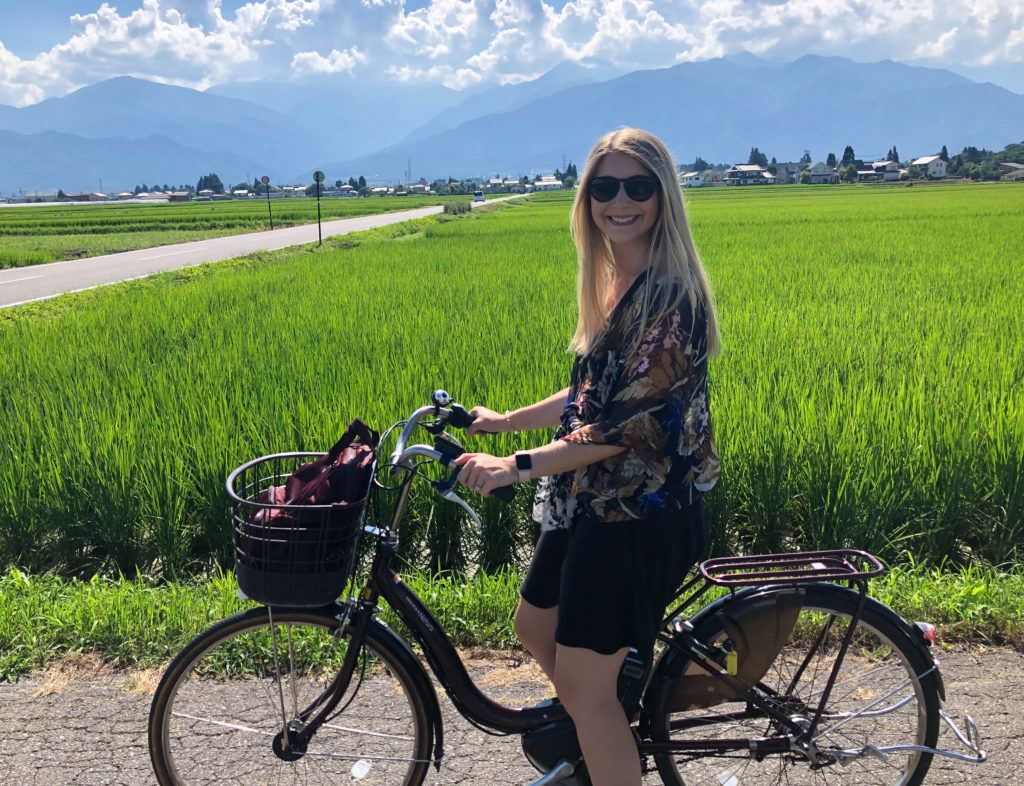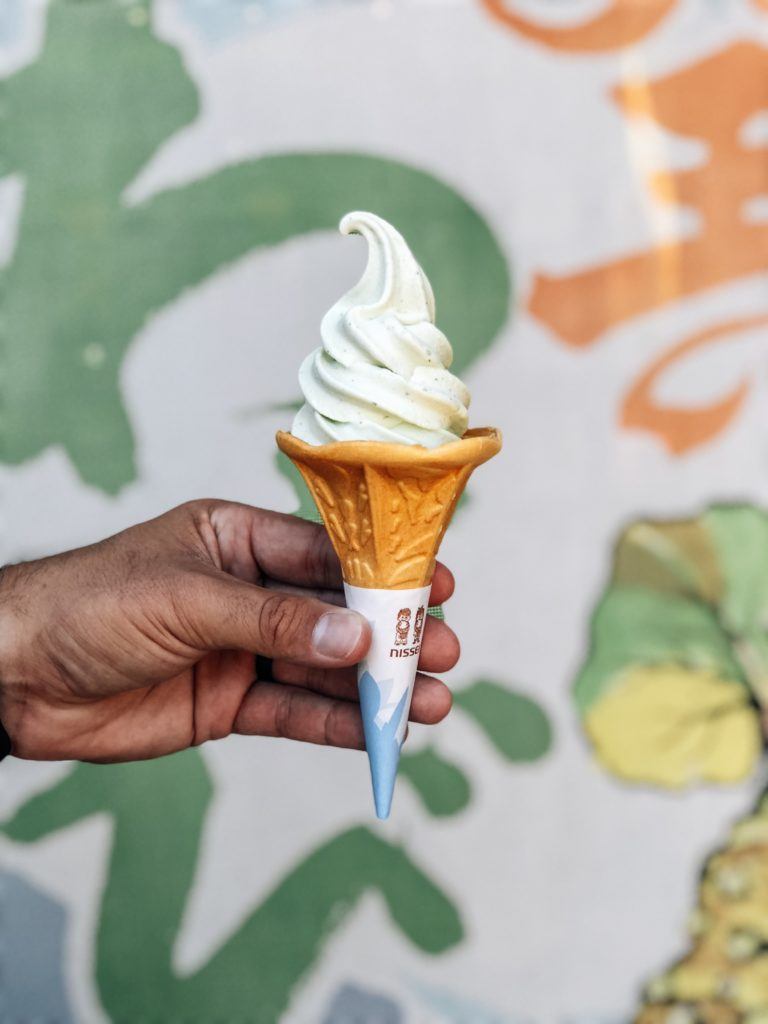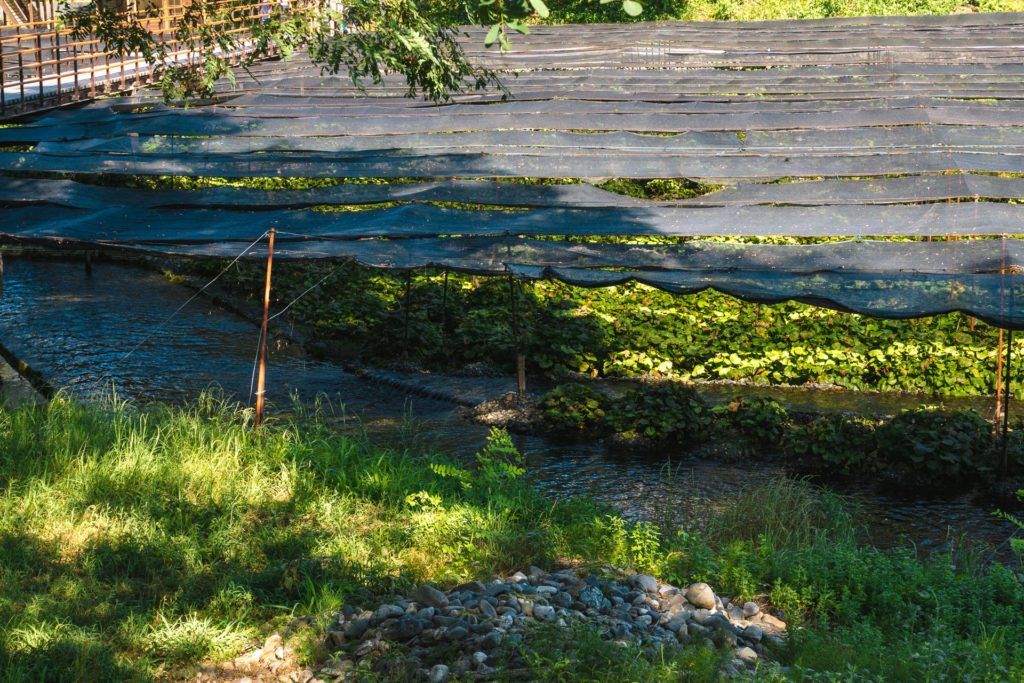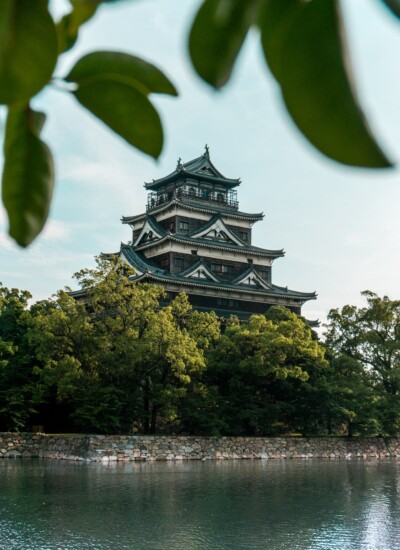Daio Wasabi Farm (大王わさび農場) in Azumino City – A Day Trip From Matsumoto
Visiting Daio Wasabi Farm has been one of the highlights of our time traveling around Japan. We loved our experience here so much we visited on two different trips! It is an educational experience that teaches visitors the tedious process of farming wasabi and a place where you can enjoy tons of wasabi snacks and sweets.
Why else should you visit Daio Wasabi Farm? Well, if you’re a big fan of wasabi, are interested in farming or agriculture, want to see what wasabi looks like and is processed, or really… ANY reason. Even if you don’t like wasabi this is still a must-do day trip from Matsumoto.
What is Daio Wasabi Farm?

Daio Wasabi Farm is a working, picturesque wasabi farm that started in 1915. Here you can see the growing process of wasabi, enjoy lunch at a small cafe, and buy wasabi-related souvenirs. It is one of the largest wasabi farms in Japan and produces around 10% of Japan’s wasabi crops covering approximately 15 hectares.
Where is Daio Wasabi Farm Located?
Daio Wasabi Farm is located in the small, rural Azumino City in the Nagano Prefecture which is about 30 minutes away by car or train from the city of Matsumoto making it the perfect day trip from Matsumoto!
How to Get to Daio Wasabi Farm


TRAVELING BY CAR TO AZUMINO CITY
If you happen to be traveling around Japan by car you can easily drive to Daio Wasabi Farm from Matsumoto which is about 25 minutes. Once you arrive at the farm there is free parking available to the right of the main building. On our second trip to the farm we were on a road trip in the Chubu Prefecture of Japan so we drove to Daio Wasabi Farm from Matsumoto.
TRAVELING BY TRAIN TO AZUMINO CITY
On our first visit to Daio Wasabi Farm, we took the JR Oita Line from Matsumoto Station to Hotaka Station (about 25 minutes, ¥330 one-way). From Hotaka Station, you can take a taxi (about a 10-minute drive) or rent a bike from Shinano (しなの庵), a small bike shop across the street from the station which is what we did!
If the weather is nice I HIGHLY recommend renting a bicycle to visit Daio Wasabi Farm and other things to do in Azumino. We rented electric bikes from Shinano which were fun to ride on the country roads.
The paths to get to Daio Wasabi Farm are paved country roads so there is minimal traffic and it’s extremely beautiful, especially on a clear, sunny day! Plus there are several routes you can take (provided by Shinano Bike Shop) that take you by shrines, temples, museums, and even a Swiss village.
WALKING TO DAIO WASABI FARM
Another option to get to Daio Wasabi Farm is by walking. We didn’t time it out but I believe it would be about a 30-minute walk based on the routes on Google Maps. Again, most of the area is paved and there are some sidewalks but if it’s possible, I’d still recommend riding a bike or renting a taxi.
Shinano Bicycle Rental Information
| Usage Time | Ordinary Bicycles | Electric Bicycles |
| 1 hour | 200 yen | 300 yen |
| 2 hours | 400 yen | 600 yen |
| 3 hours | 600 yen | 900 yen |
| 4 hours | 800 yen | 1,200 yen |
| 5 hours | 1,000 yen | 1,500 yen |
| 6 hours | 1,200 yen | 1,800 yen |
| 24 hours | 1,400 yen | 2,000 yen |
| 48 hours | 2,800 yen | 3,800 yen |
Shinano Bike Shop Hours: 8am-6pm, cash payment
Interesting Fun Facts About Wasabi

Before I start telling you about the wasabi farm, I have to give you some interesting facts about wasabi – most I didn’t know before I visited!
- Wasabi is incredibly hard to grow. It cannot handle direct sunlight with temperatures between 46 and 70 degrees and has to have clear, freshwater flowing through at all times.
- What you typically eat at home or restaurants isn’t real wasabi. Because it’s so hard to grow, wasabi is extremely expensive. Most of the wasabi you purchase in a supermarket contains horseradish, mustard powder, and maybe a hint of real wasabi. But unless the first ingredient is wasabi or wasabi japonica it isn’t pure wasabi. I was surprised at how different real wasabi tastes in Japan so even if you don’t like wasabi, give it another try!
- Wasabi has TONS of health benefits. There have been many studies showing that wasabi has anti-inflammatory and antibacterial properties due to a naturally occurring chemical called allyl isothiocyanate. It also has calcium, vitamin C, and potassium. There are several other illnesses that it’s thought to alleviate symptoms for such as allergies, inflammation, and even some cancers. Wasabi is a nutritional workhorse!
- Wasabi is an herb. Most people think that wasabi is a type of horseradish but it’s a unique plant – it is also referred to as a type of cabbage. But our friends at Daio Wasabi Farm said herb!
- The flavor of wasabi disappears quickly. If you are eating fresh wasabi it should be freshly grated right when you plan to eat it. This is because the flavor of fresh wasabi is usually gone within 15 minutes! However, the actual stem of wasabi can last for months and be grated again and again.
- Every part of the wasabi plant is edible. While we mostly eat the wasabi stem when grated for sushi, soba, or meats, the leaves of wasabi can be pickled, cooked, or chopped and added to any dish you desire.
Experiencing Daio Wasabi Farm

Okay now on to the good stuff! After we rented our bikes from Shinano we took a scenic bike ride through the rural roads of Hokata. There are a few places we could have stopped along the way (provided by the map we received from Shinano) but we decided to save them for the bike ride back!
We arrived at the farm and parked our bikes in the free bike parking area close to where the cars were parked.
The first place we visited at Daio Wasabi Farm was the Wasabi Farm Museum. Here you can learn the history of the farm and watch videos about the harvest of wasabi, its benefits, and its uses. A lot of the museum is only in Japanese, but even if you cannot read Japanese you can infer what each artifact is for.


Trying Wasabi Ice Cream & Other Wasabi Snacks
After, we went to the outdoor cafe area where we first ordered… WASABI ICE CREAM. Now I know what you might be thinking… wasabi doesn’t belong in ice cream. But now… it works. It really does.
When we first tried it I thought it was going to have a kick, but the wasabi flavor was mellow, swirled into the sweet vanilla cone. Somehow, it was surprisingly delicious and I’d go for another in a heartbeat. On our second visit to Daio Wasabi Farm, we noticed that they had a few different wasabi ice cream cones some with more wasabi flavor than others so we decided to get one that had a stronger wasabi flavor. It was still delicious but I prefer the lighter flavor because it wasn’t overpowering.


We also ordered a wasabi croquette which is a crispy potato croquette filled with wasabi greens. It was very mild in flavor but the perfect snack to have before lunch. Make sure to ask for the sauce on top which adds a nice umami flavor!

READ MORE: A Sweet Guide to Ice Cream in Japan
The Wasabi Farm Area



Next, we decided to explore the farm. The first thing you’ll notice is that the farm is well-kept and highly developed for tourists with walking paths, bridges, water features, a small shrine, and even watermills.
On the farm we were able to see how the wasabi is grown – and let me tell you it’s no easy feat! As I said before, it’s one of the hardest plants to grow with a constant need for the right temperatures. On the farm grounds, multiple large fields are meticulously taken care of by those who work for Daio Wasabi Farm.
Each of the fields has a continuous flow of crystal-clear water from the Northern Alps. Without these freshwater streams, the wasabi wouldn’t be able to thrive! Once planted, each wasabi plant takes about two years to grow. I’m never taking fresh wasabi for granted again!


During our visit in early August, we noticed that the plants were covered by black tarps. When we asked, we found out that it was to help protect the plants from the sweltering heat of summer. Clever right? Then during the visit in the fall, the tarps are rolled back to allow the plants to receive more sun.
Daio Wasabi Farm Gift Shop


Then we visited a souvenir shop! Inside are wasabi-related gift items including wasabi snacks, wasabi seasonings, wasabi beer, and even fresh wasabi. If only we could bring this back with us so we could grate our wasabi! Instead, we purchased some wasabi salt, wasabi togarashi (chili pepper seasoning), and wasabi sweets.
Before you leave you can visit the cafe again where you can enjoy local specialties like wasabi soba (buckwheat noodles) or wasabi tempura. I highly recommend tasting the freshly grated wasabi with one of these entrees to get the full experience.
Daio Wasabi Farm Information
ADDRESS: 3640 Hotaka, Azumino City, Nagano Prefecture 399-8303
HOURS: March – October 9:00am-5:20pm, November – February 9:00am-4:30pm
COST: Free to visit
BOOK A TOUR OF DAIO WASABI FARM
Where Can I Buy Real Wasabi?
You can buy real wasabi at Daio Wasabi Farm to take with you! But make sure you check with customs should you think about bringing it back to your home country.
If you are looking to purchase real wasabi in the United States you can at The Wasabi Store. They have many different wasabi products including wasabi root, plants, powders, and salts.
Other Things to Do in Azumino City
There are several other things to do in Azumino City before making your way back to Matsumoto. On our bike ride, we stopped by a few small shrines and enjoyed a bike trail by a scenic riverway and forest. Here are just a few more ideas of places to visit.
Hotaka Shrine (穂高神社)
Hotaka Shrine is located close to Hotaka Station making it the perfect place to visit as your first or last stop in Azumino City. It has many gorgeous features including the wooden torii gate towards the entrance and has a lot of information about the city too.
Location: 6079 Hotaka, Azumino, Nagano 399-8303, Japan // MAP
Tokoji Temple (東光寺)
Tokoji Temple is also located close to Hotaka Station, Tokoji Temple is a very unique temple to visit in Japan. It has the main elements of most temples with historic gates and architecture, but also a few modern elements like large wooden geta (sandals) that you can take photos with.
Location: Japan, 〒399-8303 Nagano, Azumino, Hotaka, 等々力2721 // MAP
Manganji Temple (満願寺)
Manganji Temple is tucked away in a scenic location that requires a short hike to get there. There are numerous Buddhist paintings on the walls of this temple, a large bronze bell you can ring to send a wish to the gods, and a beautiful garden and brook.
Location: 1812 Hotakamaki, Azumino, Nagano 399-8305, Japan // MAP
Alps Azumino National Government Park (国営アルプスあづみの公園)
Alps Azumino National Government Park is a beautiful park where you can see seasonal flowers, foliage, cherry blossom trees, and a stunning view of the white-capped Mount Jonen in the background.
There are also several activities you can enjoy in the park like frisbee golf, hiking trails, soba-making classes, craft activities for kids, and outdoor trampolines.
Location: Japan, 〒399-8211 Nagano, Azumino, Horiganekarasugawa, 33−4 // MAP
Cost: ¥400/adults, ¥80/children
Rokuzan Art Museum (碌山美術館)
Rokuzan Art Museum is a scenic art museum that is located in the heart of Hotaka. It displays the works of Japanese sculptor, Rokuzan Ogiwara. But in addition to the beautiful works inside, the outside is something to marvel at as well. Built to resemble a church, in honor of Rokuzan’s Christian faith, the brick exterior and stained glass windows are very beautiful.
Location: 5095-1 Hotaka, Azumino, Nagano 399-8303, Japan // MAP
Cost: ¥700/adults, ¥300/high schoolers, ¥150/elementary and junior high
Azumino Winery (安曇野ワイナリー)
Azumino Winery is a small, scenic winery that overlooks the Northern Alps. At the winery, you can enjoy free tastings or purchase bottles of wine to be enjoyed in the cafe or outside on the terrace overlooking the vineyard. They also offer tours through the growing, brewing, and bottling process of their wines. Don’t forget to take a bottle with you to take home in your suitcase!
Location: 6687-5 Misatoogura, Azumino, Nagano 399-8103, Japan // MAP
Hours: 10:30am-4pm, Thursday-Monday. Closed Tuesday & Wednesday.
Azumino Swiss Village (安曇野スイス村)
Azumino Swiss Village is a small village area with buildings resembling Swiss architecture and many different attractions including horseback riding, a winery, and TONS of edible souvenirs. There is also rice paddy art to view seasonally!
Location: Toyoshinaminamihotaka, Azumino, Nagano 399-8201, Japan // MAP
Hours: 8:30am-6pm daily
We hope this post has inspired you to visit Azumino City and Daio Wasabi Farm! Now we’re off to make some soba noodles with a side of wasabi.



Leave A Reply!